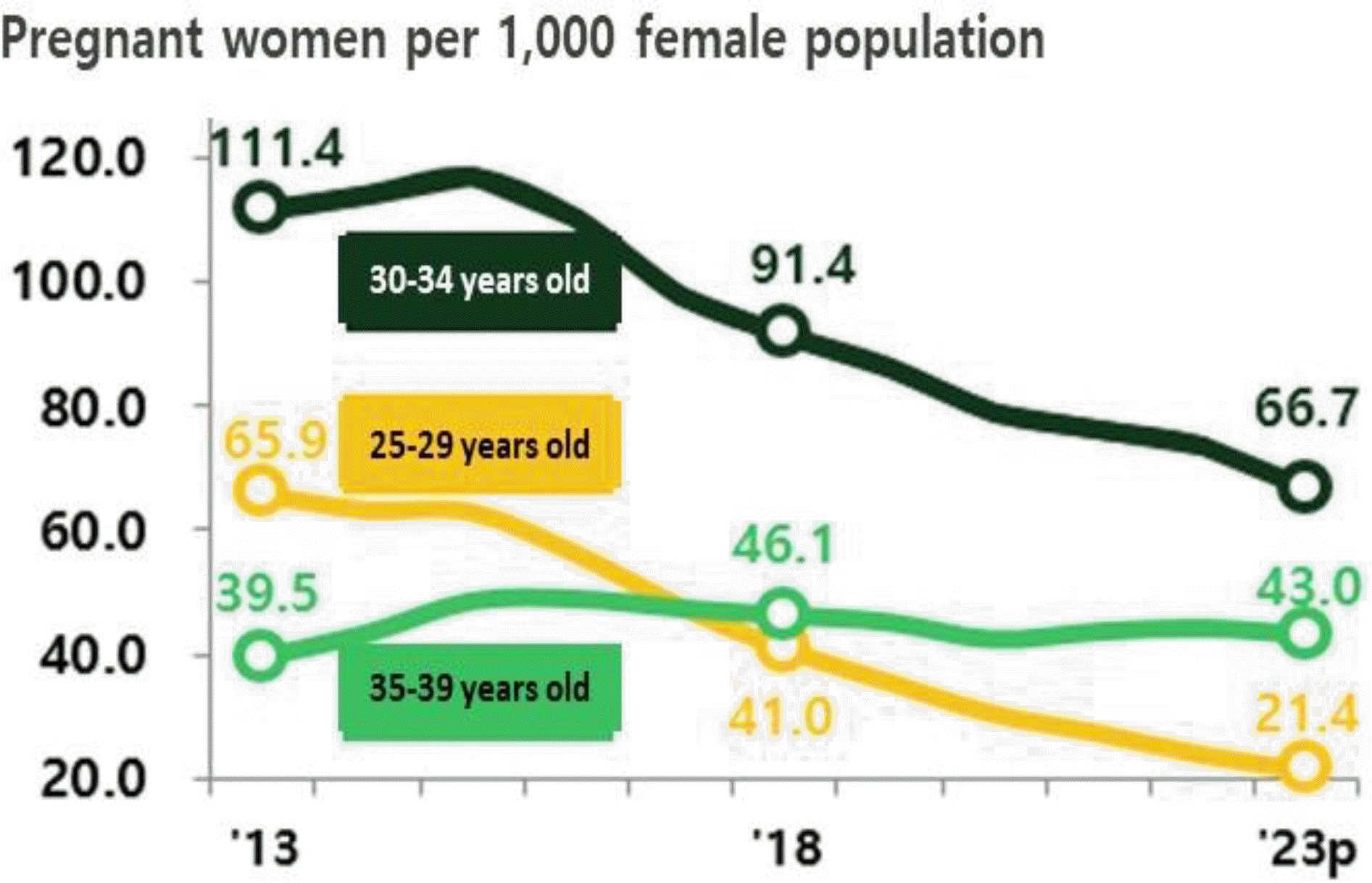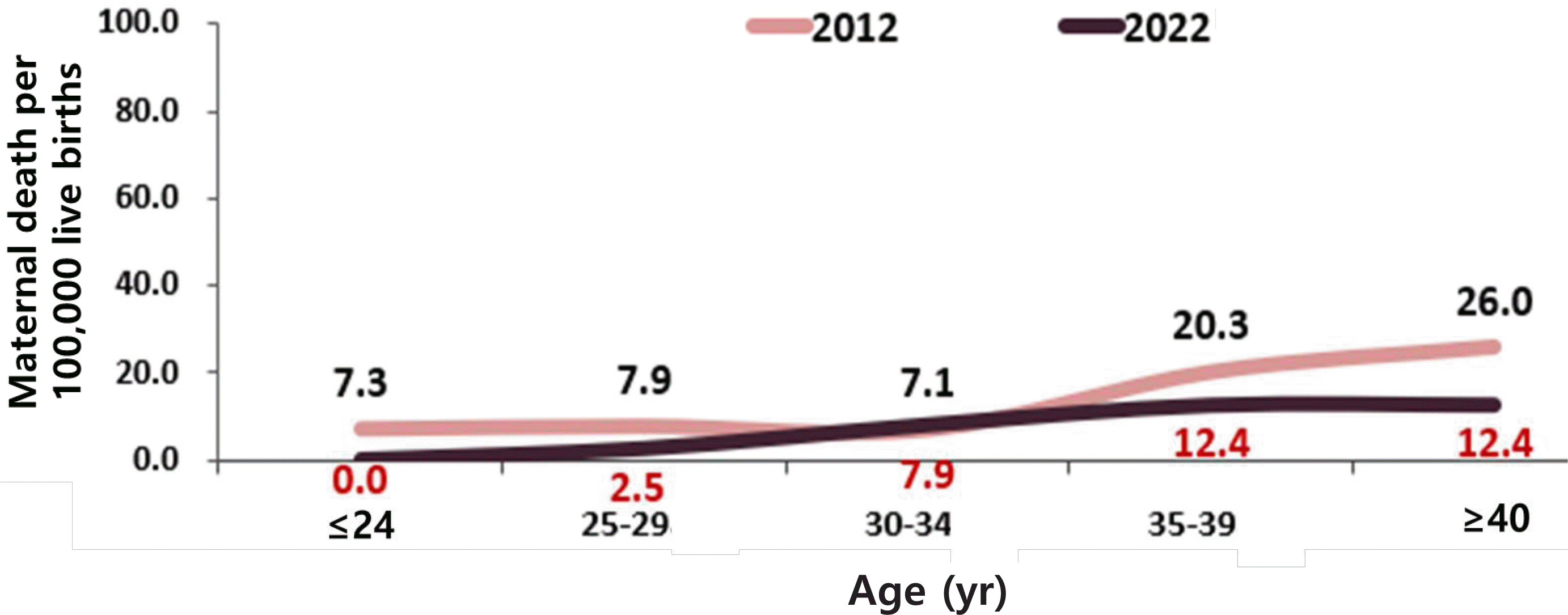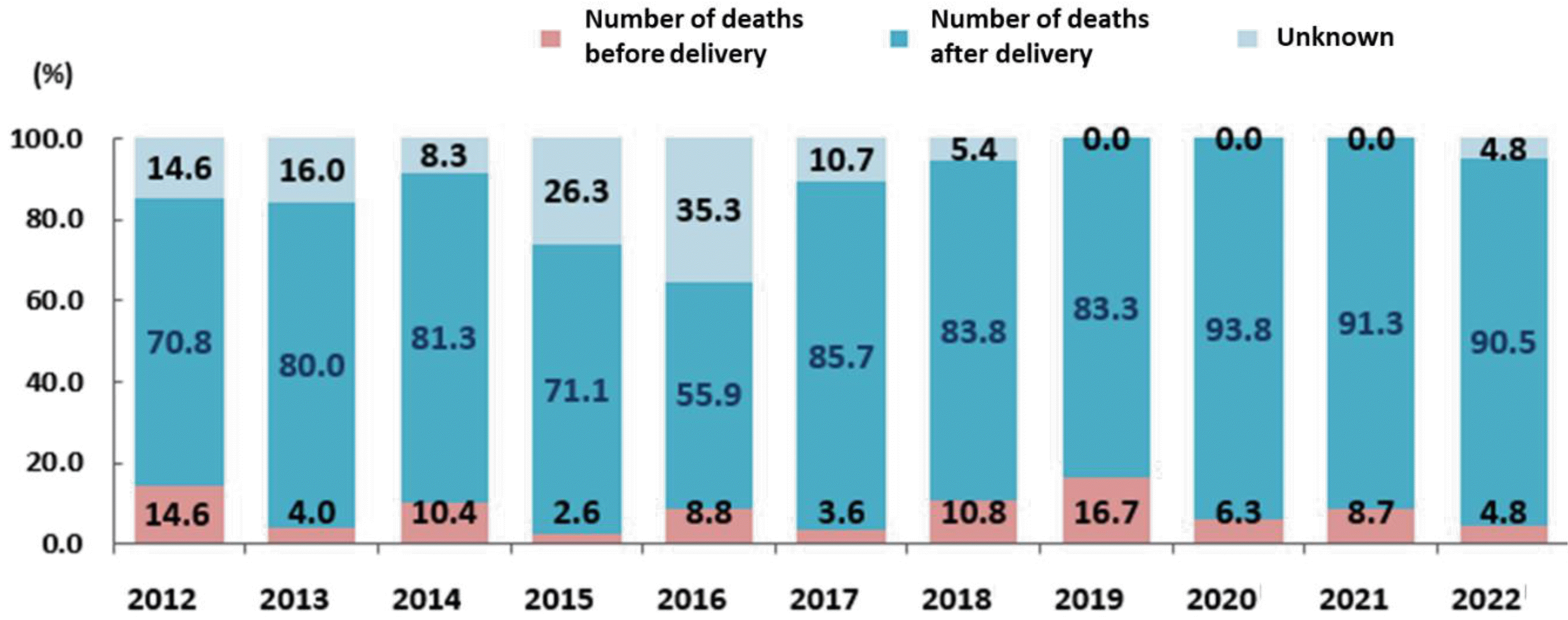This article has been
cited by other articles in ScienceCentral.
Introduction
Republic of Korea recently entered an era of ultra-low fertility. The total fertility rate in the country dropped below 1, reaching 0.977 in 2018 and 0.72 in 2023 (
Statistics Korea, 2024). The increase in late marriages has led to a rise in the average age of women's first pregnancies. Consequently, the number of mothers over 35 years of age is increasing (
Statistics Korea, 2024). Pregnancies at an older maternal age have a higher risk of complications, including preeclampsia, placental abruption, preterm birth, and gestational diabetes. Maternal mortality is also a major concern due to the increasing number of these high-risk pregnant women.
Each year, the Office for National Statistics publishes infor-mation on maternal, infant, and perinatal deaths, with cause of death statistics providing an overall picture of mortality trends. These maternal mortality statistics offer insights into the health of pregnant women and serve as an important basis for public policy. In this editorial, I would like to briefly comment on the current trends and causes of maternal deaths in Korea based on the latest data released by Statistics Korea.
Trend of Maternal of Age in Republc of Korea
The average age of a woman's first pregnancy is rising as the age of marriage increases. Therefore, the number of pregnant women aged 35 and older is increasing.
Fig. 1 shows the number of pregnant women per 1,000 female population by age. In 2023, about 43 pregnant women per 1,000 female population were aged 35 or older. The number of pregnant women aged 25 to 29 and 30 to 34 has been steadily decreasing over the past decade, while the number of pregnant women aged 35 to 39 has remained unchanged (
Fig. 2) (
Statistics Korea, 2024). The average age of pregnant women has also increased. Pregnancies in older women are associated with a higher risk of pregnancy-related complications, including preeclampsia, placental abruption, preterm birth, and gestational diabetes.
Fig. 2 shows maternal mortality rates by age (
Statistics Korea, 2024). When comparing maternal mortality rates by age in 2012 and 2022, we see a pattern of sharp increases in maternal mortality rates in 2012 for those aged 35 and older. In 2022, the highest maternal mortality rates (12.4 deaths) are found in the women aged 35 to 39 and aged 40 and older groups, while the lowest (2.5 deaths) is found in the women aged 25 to 29 group (
Fig. 2) (
Statistics Korea, 2024).
Fig. 1.

Fig. 2.

Trend of the Maternal Mortality Rate in Republic of Korea
This figure shows recent maternal mortality rates in Republic of Korea (
Fig. 3) (
Statistics Korea, 2023). Maternal deaths in the Republic of Korea in 2021 totaled 23, with a maternal mortality ratio of 8.8, lower than the Organization for Economic Cooperation and Development (OECD) average of 11.8 during the same period (
OECD Data Explorer, 2020). According to the most recently announced statistics, the number of maternal deaths in 2022 was 21, and the maternal mortality ratio was 8.4. This represents a 4.4% decrease from the previous year (
Statistics Korea, 2023).
Fig. 3.
Maternal mortality ratio and maternal death in Republic of Korea (
Statistics Korea, 2023). OECD, Organization for Economic Cooperation and Development.

Table 1 is the latest data on maternal deaths and maternal mortality rates by province for 2021-2022. It shows that the total maternal mortality rate in 2022 decreased by 0.4% com pared to 2021. The highest maternal mortality rate was in Chungcheongnam-do (29.4), while 8 regions had the lowest maternal mortality rate of “0”: Gwangju, Ulsan, Sejong, Gangwon-do, Jeonbuk-do, Jeollanam-do, Gyeongsangnam- do, and Jeju-do (
Table 1) (
Statistics Korea, 2023).
Table 1.
Number of maternal deaths and maternal mortality ratio by province (2021–2022)
|
Province |
Maternal death by province |
Maternal mortality rate by province |
|
2021 |
2022, n (%) |
Incre/Decre |
2021 |
2022 |
Incre/Decre |
Rank |
No. of births (%) |
|
Total |
3,152 |
3,073 (100) |
-79 |
12 |
12.2 |
0.2 |
|
252,259 (100) |
|
Seoul |
537 |
531 (17.3) |
-6 |
11.7 |
12.3 |
0.7 |
9 |
43,133 (17.1) |
|
Busan |
166 |
188 (6.1) |
22 |
11.4 |
13.1 |
1.8 |
6 |
14,322 (5.7) |
|
Daegu |
135 |
177 (5.8) |
42 |
12.5 |
17.2 |
4.7 |
1 |
10,311 (4.1) |
|
Incheon |
188 |
158 (5.1) |
-30 |
12.4 |
10.8 |
-1.6 |
12 |
14,622 (5.8) |
|
Gwangju |
93 |
78 (2.5) |
-15 |
11.6 |
10.4 |
-1.2 |
14 |
7,524 (3) |
|
Daejeon |
102 |
96 (3.1) |
-6 |
13.6 |
12.4 |
-1.2 |
7 |
7,773 (3.1) |
|
Ulsan |
67 |
50 (1.6) |
-17 |
10.8 |
9.2 |
-1.6 |
15 |
5,449 (2.2) |
|
Sejong |
31 |
40 (1.3) |
9 |
8.6 |
12.3 |
3.7 |
8 |
3,249 (1.3) |
|
Gyeonggi-do |
886 |
921 (30) |
35 |
11.5 |
12.1 |
0.6 |
10 |
76,244 (30.2) |
|
Ganwon-do |
78 |
64 (2.1) |
-14 |
10.5 |
8.7 |
-1.8 |
17 |
7,342 (2.9) |
|
Chungchongbuk-do |
139 |
100 (3.3) |
-39 |
16.7 |
13.2 |
-3.4 |
4 |
7,552 (3.0) |
|
Chungcheongnam-do |
121 |
111 (3.6) |
-10 |
10.9 |
10.7 |
-0.2 |
13 |
10,332 (4.1) |
|
Jeonbuk-do |
109 |
103 (3.4) |
-6 |
14.4 |
14.4 |
0.1 |
2 |
7,135 (2.8) |
|
Jeollanam-do |
98 |
111 (3.6) |
13 |
11.5 |
13.9 |
2.4 |
3 |
7,999 (3.2) |
|
Gyeongsangbuk-do |
157 |
125 (4.1) |
-32 |
12.9 |
10.9 |
-1.9 |
11 |
11,436 (4.5) |
|
Gyeongsangnam-do |
189 |
188 (6.1) |
-1 |
12 |
13.2 |
1.2 |
5 |
14,205 (5.6) |
|
Jeju-do |
56 |
32 (1) |
-24 |
14.8 |
8.8 |
-6 |
16 |
3,631 (1.4) |
Cause of The Maternal Mortality Rate in Repubic of Korea
According to the World Health Organization (WHO), the major complications causing maternal death are: severe bleeding (mostly after childbirth); infections (usually after childbirth); high blood pressure during pregnancy (preeclampsia and eclampsia); complications from delivery; and unsafe abortion (
Say et al., 2014). The causes of maternal mortality can be broadly divided into 2 categories. Direct cause include complications related to the puerperium/ complications of labor and delivery/ hypertensive disorder/ other obstetric conditions/maternal care-related problem/ pregnancy with abortive outcome. Indirect cause means that maternal death resulting from pre vious existing disease or disease that developed during preg nancy and that was not due to direct obstetric causes, but that was aggravated by physiologic effects of pregnancy (
WHO, 2024).
According to recent statistics, direct obstetric deaths, mainly due to complications related to the postpartum period, accounted for 81% of all maternal deaths. Among direct obstetric causes, complications related to the puerperium period and complications of labor and delivery accounted for 61.9% of all maternal deaths. Complications related to the puerperium include obstetric embolism, and complications of labor and delivery include postpartum hemorrhage. Indirect obstetric deaths were 4, accounting for 19% of all maternal deaths, a decrease of 2 from the previous year (
Table 2) (
Statistics Korea, 2023).
Fig. 4 shows the number of maternal deaths by time of death. Compared to previous years, there has been a recent trend toward more postdelivery deaths, with more than 90% of maternal deaths occurring in the postpartum period in 2022 (
Statistics Korea, 2023).
Table 2.
Number of maternal deaths and maternal mortality ratio by province (2021–2022)
|
Cause of the maternal death |
2021 |
2022 |
Compared to previous year |
|
No. of deaths |
Composition ratio |
No. of deaths |
Composition ratio |
Incre/decre |
Incre/decre rate |
|
Total |
23 |
100.0 |
21 |
100.0 |
-2 |
-8.7 |
|
Direct cause |
17 |
73.9 |
17 |
81.0 |
0 |
- |
|
Complications related to the puerperium |
4 |
17.4 |
8 |
38.1 |
4 |
100.0 |
|
Complications of labor and delivery |
8 |
34.8 |
5 |
23.8 |
-3 |
-37.5 |
|
Hypertensive disorder |
3 |
13.0 |
0 |
- |
-3 |
-100.0 |
|
Other obstetric conditions |
1 |
4.3 |
3 |
14.3 |
2 |
200.0 |
|
Pregnancy with abortive outcome |
0 |
- |
1 |
4.8 |
1 |
- |
|
Maternal care-related problem |
0 |
- |
0 |
- |
0 |
- |
|
Other maternal disorders |
1 |
4.3 |
0 |
- |
-1 |
-100.0 |
|
Indirect cause |
6 |
26.1 |
4 |
19.0 |
-2 |
-33.3 |
|
Incre/Decre, increase/decrease. |
|
|
|
|
|
|
Fig. 4.

Share of Solutions
A recently published study compared maternal and neonatal health care access between areas without maternal-fetal intensive care units (MFICUs) and neonatal intensive care units (NICUs) and nearby areas (
Lee et al., 2022). The study compared the perinatal medical care service areas (PMCSAs) where institutions with NICUs and MFICUs are located among 70 hospital service areas across the country. They also assessed perinatal outcomes, including maternal mortality and perinatal mortality, for each PMCSA and compared these between underserved and well-served areas classified by degree of access to NICUs and MFICUs. The results of this study showed that maternal mortality rates in underserved and vulnerable areas for maternal and neonatal healthcare access were 14.28 and 9.48, respectively. This rate was significantly higher in less accessible areas (p=0.022) (
Lee et al., 2022).
Because the maternal mortality rate is high in vulnerable areas, we need a system to protect mothers in these regions. For postpartum hemorrhage, which accounts for the largest proportion of maternal deaths, access to a secondary or tertiary hospital is an important determinant of maternal mortality. In the early stages of postpartum hemorrhage, conservative ma-nagement with medication and blood transfusion is possible, but if bleeding is excessive, invasive treatments such as uterine artery embolization or balloon insertion are necessary. If vital signs such as blood pressure or heart rate are unstable, or bleeding continues even after receiving the above treatment, hysterectomy should be considered.
Although deficiencies in the transport system are one of the main reasons, difficulty in accessing hospitals for appropriate treatment may also be a decisive reason for the high maternal mortality rate. In Korea, the distribution of hospitals capable of providing maternity care varied greatly by region. Accordingly, several studies have suggested that the prognosis of mothers and newborns can be improved by establishing a regional perinatal care sharing system so that high-risk pregnant women and later high-risk newborns can receive appropriate perinatal care. Specific measures for establishing a medical care sharing system and emergency transport systems that can be applied to actual situations must be presented through policy.
Conflict of interest
The author has nothing to disclose.
Acknowledgments
This study was presented at the 23rd Congress of the Federation of Asia and Oceania perinatal Societies, Seoul, Republic of Korea, September 4–6, 2024.
REFERENCES
Lee JH., Kwon HS., Noh YM., Shin H., Kim T., Lee TH, et al. Perinatal outcomes according to accessibility to maternal-fetal and neonatal intensive care units by region in Korea. J Korean Med Sci. 2022. 37:e77.

Say L., Chou D., Gemmill A., Tunçalp Ö., Moller AB., Daniels J, et al. Global causes of maternal death: a WHO systematic analysis. Lancet Glob Health. 2014. 2:e323–33.

Statistics Korea. Infant mortality, maternal mortality, and perinatal mortality statistics for 2023 [Internet]. Daejeon (Korea): Statistics Korea;2023. [cited 2024 Oct 7]. Available from:
https://www.kostat.go.kr/unifSearch/search.es.

